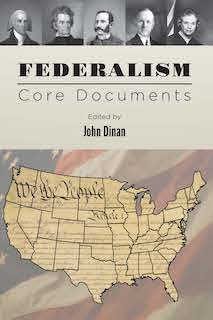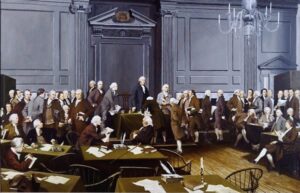
A Conversation with John Dinan, Editor of Federalism
Does Federalism Improve American Civic Life and Protect Civil Liberties?
Teaching American History recently released the final volume in our series of document collections on American government: Federalism: Core Documents. Edited by Professor John Dinan, the volume offers 45 document excerpts illuminating the American federal system, that is, the complex way in which our Constitution apportions power between the federal government and the governments of the 50 states. The volume shows how the founders understood federalism and how the system has been interpreted and applied in the years since our Constitution was ratified.
We asked Professor Dinan to explain why the concept of federalism is relevant to US history and government.
Why is it important for teachers and students understand the concept of federalism?
To study federalism means to study how governance takes place in the United States, where power is divided and shared at multiple levels. There are a few things that are handled only at the national level or only at the state level. But the vast majority of governance is shared in some ways between the two. If we’re interested in education policy, drug policy, social welfare programs, environmental policy—we could go on!—we have to understand that the federal government and state governments all have a role to play. And that turns us to questions of federalism.
Compared to the governments of other nations, is our federal system unique?
Just under 30 countries in our world have governments that are categorized as federal systems. Such systems are those in which there is some degree of autonomy at the sub-national or state level, and some degree of power exercised at that level that is not just given by the grace of the national government, but is embedded in the country’s constitutional system.
Each of the countries in North America has a federal system. In South America, you find federal systems in Brazil and Argentina; in Europe, you find them in Germany, Austria, and Switzerland. In Africa, Nigeria, Ethiopia, South Sudan, and South Africa have all adopted federal systems. Australia uses a federal system, as do some countries in Asia. Although you can find federal systems on every continent, they constitute a minority of the political systems around the world.
While many of these countries drew heavily on the American example in designing their federal systems, few followed the US in according as much authority to their sub-governments (most of which in other systems are called “provinces” or “cantons” instead of “states”). In the US, state governments are allowed to raise their own revenue and impose their own taxes. In most other federal systems, the money is raised at the federal level and then distributed to the state governments. When you are taxed not only from Washington, DC but also from Raleigh, North Carolina, you can’t fail to be aware of state government.
Does the federal system matter as much today as it once did? In some ways, citizens today seem less aware than earlier generations of programs and policies that are shaped at the state level. Elections of Congressmen today seem to turn on national issues—defense; immigration and “border security”; national economic policy, and so on.
Federalism still matters a great deal, and examples are not hard to find. In presenting this to students, we used to talk about marijuana legalization. The federal government criminalizes marijuana cultivation, sale and possession. Yet, decades ago, state governments began to go their own way. California led in this, removing state penalties for the use of medical marijuana back in 1996. Then, in 2012, the states of Washington and Colorado took the first steps to remove state criminal penalties for recreational marijuana. Today, nearly half of the states have legalized recreational marijuana and about three quarters of the states have legalized medical marijuana. Whether or not and in what circumstances marijuana use is penalized depends on the state one lives in. Document 44 in our collection addresses this; it’s a memo from the Obama administration’s Justice Department directing federal attorneys around the country not to enforce federal marijuana law in states that have adopted contrary policies.
Abortion policy is now more likely to be the entry point for discussions of federalism in many classrooms, because of the US Supreme Court’s decision in the Dobbs case in the summer of 2022 (Document 45 in our collection), overturning Roe v. Wade. In finding no federal constitutional right to abortion, the court returned abortion policy to the state level. During the year since the decision came down, many states have crafted their own abortion policies. In a few cases, legislators have decided that abortion shall not be permissible at any time during pregnancy. Other states have gone in the opposite direction, writing laws specifying that at no time during a pregnancy will abortions be prohibited. A number of other states have taken a middle way; they’ve imposed some restrictions on abortion, but not criminalized them entirely.
When I was growing up in Virginia and got together with my cousins from other states, we’d talk about when we could get our drivers’ licenses. Some of us could qualify for a learner’s permit at age 15 and then for a license at 16; others couldn’t get a license until age 17. Of course, once we grew up and started paying taxes, we became very conscious of which states had higher sales taxes and which higher income tax rates—and which states did not impose one or the other tax at all. Some citizens make decisions about where to move or live based on these differing tax policies. The impact of federalism is all around us.
Americans are a mobile people. Doesn’t federalism cause a lot of confusion and inconvenience?
We may be more aware today than in the past of the problems federalism creates. But at the time of the founding, the prospect of a unitary, strong central government seemed a far greater threat than any of the difficulties attendant on federalism.
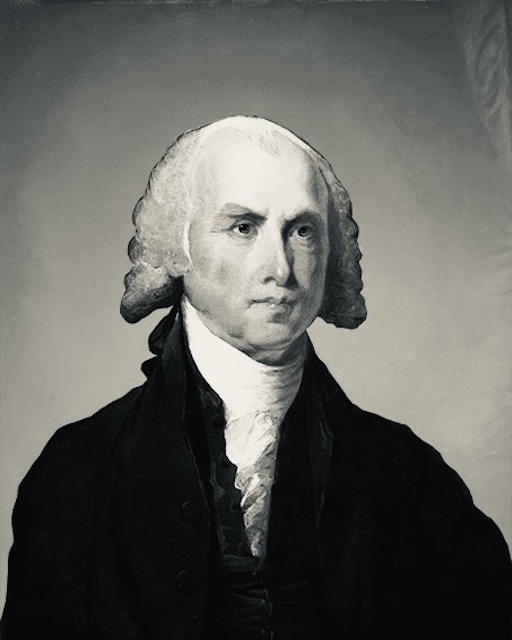
How to strike a balance between central and state government authority was the problem James Madison confronted prior to the Constitutional Convention. To prepare himself for the deliberations, he read all the political theory and history he could find, and all that his friends could send him, on the design of federal systems. After the convention, writing under the guise of Publius for the series known as The Federalist, he said that the US Constitution established a model for government unlike any ever seen before. Previously, there had been confederations of states, in which the states held the dominant power and granted power to the central government only as they saw fit. There had been unitary governments, where the dominant power rested in the national government, which apportioned power out to the provinces only as it saw fit. The American federal system, Madison declared, had split the atom of sovereignty. If you asked him, “Well, where does sovereignty rest?” he would say it really rests in the people. The people, deciding where they placed the greater confidence, would determine whether to allow the national government or the state governments to exercise more power.
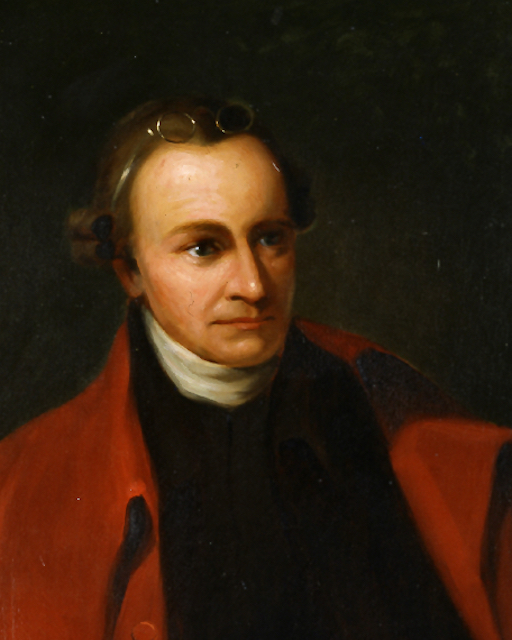
Still, Patrick Henry, in his speech to the Virginia ratifying convention, warned that under the new Constitution, all power would flow to the central government; the state governments would become meaningless. Although the Federalists prevailed in the fight over ratification, the argument did not end there.
Evidence for this can be seen in the controversies over “interposition” and “nullification.” From the 1790s through the 1850s, states thought that it was well within their authority, and was in fact proper, for them to issue rulings calling the federal government to account when they believed it had passed laws inconsistent with constitutional principles. The Virginia and Kentucky Resolutions of 1798 were written in response to the Alien and Sedition Acts, which were seen as an abuse of federal power. Madison authored the Virginia Resolutions—Document 10 in our collection—which were circulated to the other states with an appeal for support in repealing the laws.
Document 11 in our collection shows the Massachusetts legislature’s response to this appeal. They completely rejected the claim that state legislatures could pass judgment on the constitutionality of federal laws; it was the job of the Supreme Court to do that. (That is the position taken by most people today.) After receiving the responses of Massachusetts and other states, Madison drafted a report (Document 12) insisting that it’s not just the job of the US Supreme Court to watch over the federal government; if the liberties of the citizens are being violated by an act of the federal government, the people expect state governments to protest. And in fact, a decade later, the Massachusetts legislature took this position. It stated its opinion that the Embargo Act of 1807 was “in many respects, unjust, oppressive, and unconstitutional, and not legally binding on the citizens of this state” (Document 13).
John Calhoun, speaking on behalf of South Carolina, took the argument to the next level in the 1830s. Voicing his opinion that the Tariff Act of 1828 was unconstitutional, he also claimed that South Carolina had the right to declare the act null and void within the state. This, of course, prompted the Nullification Crisis of 1832.
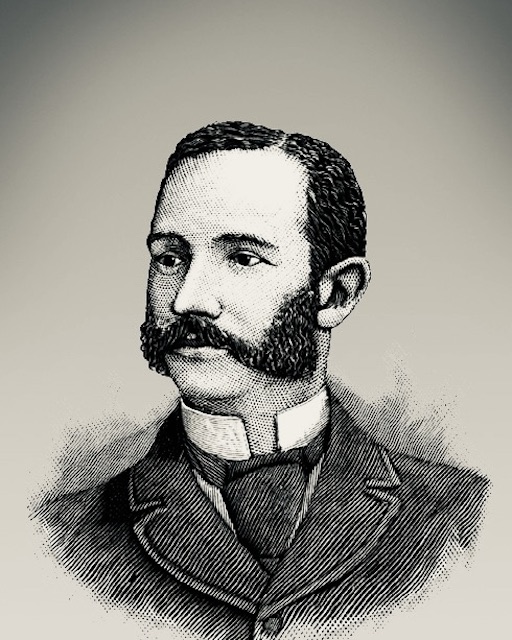
And just prior to the Civil War, the Wisconsin legislature passed a joint resolution (Document 21) in response to the US Supreme Court’s ruling in Ableman v. Booth (1859) sustaining the Fugitive Slave Act. It’s a very complicated case, but it illustrates the objection of many in the north to participating in the process of returning into bondage those who had escaped slavery.
Of course, one knock against federalism is that during much our history it allowed states to enact policies in conflict with core American principles, especially policies denying racial equality. In deference to southern delegates’ insistence on their right to property in human beings, the founders shied away from a federal policy outlawing slavery, postponed the end of the transatlantic slave trade, and sanctioned the return of fugitives to those claiming ownership of them. This created a deep division between northern and southern states that was settled only by civil war. And even after emancipation, federalism allowed southern states, for many decades, to enforce racial segregation by law and to deprive African Americans of their voting rights. We include in the document collection the Platform of the States’ Rights Democratic Party, written in 1948 (Document 33), which explicitly states a commitment to racial segregation, based on their belief in distinctions among the races—in effect, their denial of racial equality.
The arguments over interposition and nullification during the first century following the founding, like the formation of the States’ Rights party in the 20th century, illustrate Americans’ forceful assertions of states’ rights. Often, they’ve asserted a right to call the central government to account for departing from what they see as constitutional principles. Given this history, we should not be surprised that federalism remains an important element in our system of balanced powers!
Are there ways in which federalism actually benefits the country as a whole?
Many have argued so. Justice Louis Brandeis, whose dissent to a 1930s case is included in the document collection, famously observed that because of our federal system, states can serve as “laboratories of experimentation.” That has very much been the case. When one state legalized medical marijuana, other states watched to see whether that created problems before following suit. When Oregon took the lead on legalizing physician-assisted suicide, certain other states watched before following; and when they did adopt similar laws, they shaped them to adjust for things they’d seen in Oregon that had not worked out as ideally as possible. In the case of marijuana legalization, many delegations of state officials headed out to Colorado to ask, “How is it working here? And would you do anything different if you did it again?”
One little-known document in the reader is an excerpt of the report of the Kestnbaum Commission (Document 34), which was tasked by Eisenhower in the 1950s to survey the entire American federal system and assess how well it was working. The report summarized both the problems and the benefits of the system. Federalism makes it really difficult to coordinate policy at the state and federal level, where you have so many different actors and officials in the mix. Yet it offers significant advantages. The commission echoed Justice Brandeis’ comments on the value of experimentation in policies at the state level. They also said federalism allows for policymaking befitting the different cultures of the states. It’s of course true that the political culture of New England differs from that of the southern states, and that both differ from that of the Pacific Northwest. On some issues today—take gun control laws, for example—it would be very difficult to imagine uniform national policies fitting all those political cultures. Ultimately, the report echoed Madison in saying that it is up to citizens to decide whether to demand national policy solutions or to accept diverse policy approaches and outcomes.
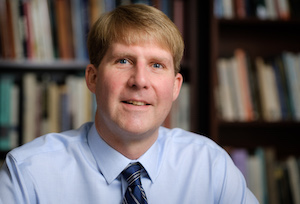
John Dinan is professor of politics and international affairs at Wake Forest University. His research focuses on federalism, state constitutions, and American political development. He authored the study, The American State Constitutional Tradition (University Pres of Kansas, 2006) and edits Publius: The Journal of Federalism. Dinan also teaches in the Master of Arts in American History and Government program of Ashland University.

